#i need to make a master list of mobility/pain management tools I use daily
Explore tagged Tumblr posts
Text
If you struggle getting out of bed at times and haven't tried a bedside standing rail or grip, I beg you to consider one. I have an adjustable bed, which is hugely helpful, but the grab bar is equally important. When mine broke this year, my partner surprised me with a new one as soon as he could because it makes that much of a difference in my daily life. It is important to find a style that works for you and your bed/bed frame. But please! Try one!
#i need to make a master list of mobility/pain management tools I use daily#but this one really is so important#chronic pain#spoonie
123 notes
·
View notes
Text
The Best Strategy to Increase Traffic and Leads to Your Real Estate Website without Any Referrals, Facebook or Paid Ads

Is your real estate business relying on referrals to close more deals? Are you paying for Facebook or Instagram ads and not even breaking even? Are you looking for other ways to generate more traffic and leads, while increasing your ROI? Fact: the online space is no different from the offline world. Real estate transactions are based on trust, and trust takes time to build because it requires genuine conversations and multiple interactions before deals are successfully closed. Therefore, the issues causing stress and anxiety in the life of your prospect hold the key to building relationships with your target market. How, you may ask? Well, TV shows have mastered the formula. At the beginning of an episode, a problem is introduced, which is normally resolved by the end of the episode. However, right before the episode ends, another problem is introduced, compelling viewers to watch the next episode. You can also use this formula effectively in your industry. Here’s how: Treat your content (article, blog post, podcast, etc.) like one continuous story. However, instead of creating a problem or inventing anxiety, you’ll tap into your prospect’s existing anxiety about the real challenges they face already. I’m NOT referring to manipulation or exploitation tactics here. We’re talking about providing meaningful content ideas and relevant solutions to your prospects to solve a specific issue in their lives. This is the main reason you entered the real estate business in the first place, right? So… do you want to move prospects through your sales funnel with ease? Here's how your real estate experience and industry insights can transform this strategy into increased traffic and leads for your company. (1) Uncover the most significant problems and associated pain points that face your prospects Explain why it's a problem, and discuss the consequences of ignoring it. Highlight a few of the mistakes beginners make, and help them understand that there are more pitfalls out there. Example:
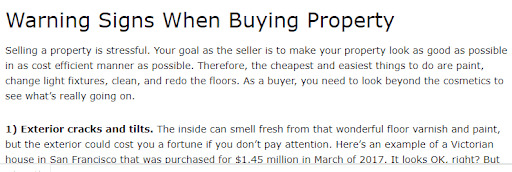
Aggravate the problem until the prospect realize the gravity of the situation, and desperately needs a way out, or a quick fix.
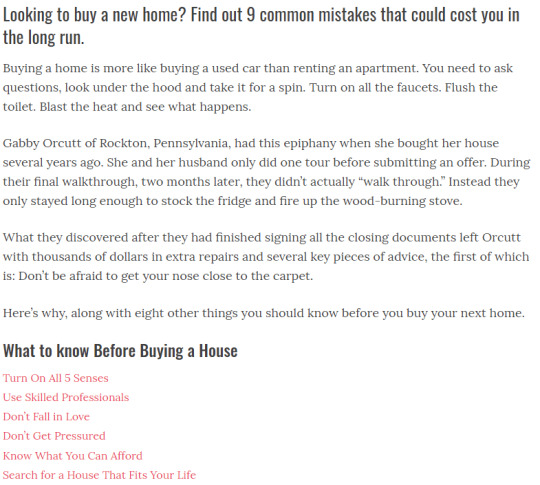
(2) Present the solution Your solution should solve their problem completely, not just relieve the symptoms or eliminate the negative consequences already present. (3) Lead prospects into your ultimate funnel

A marketing funnel is ideal for building trust with multiple prospects at the same time. Once they review your content they’ll learn more about you, as well as your real estate experience, offers, and other relevant information. Sooner rather than later, they’ll recognize that you: Understand their problem Know how to solve it, and Are a reliable and knowledgeable source. Pretty straightforward, isn't it? Unfortunately, this simple process is something real estate businesses continually ignore. Don’t fall into the same trap! Your real estate website requires an effective lead generator strategy! So, stop ignoring the best lead capture channel! I’m referring to the second most visited website after Google, YouTube. If you’re watching videos online, then your prospects are probably doing the same thing. So, why not exploit this convenient platform for the benefit of your business? Here’s how to take full advantage of this channel, and out-smart your competition with awesome video marketing content.
The #1 Reason WHY Youtube Is Not Optional For Your Real Estate Company or WebSite
An increasing number of people are using YouTube on a daily basis.

Statista reported that YouTube accounts for 37% of ALL mobile internet traffic.

YouTube, on mobile alone, is reaching more 18-34 year olds in the US than any TV network.

Video content, especially on YouTube, simplifies the process of familiarizing people with real estate companies and agents. Plus, multiple marketing tests show that YouTube videos can rank on Google much faster and much easier than articles or blog posts. That’s not all! VIDEO beats all the other content media types since it communicates on a more personal level. However, creating video content is more challenging since it requires more time and a higher level of skill. Therefore, many people find it frustrating to create exceptional content on a regular basis, and ultimately choose to give up instead of forging ahead. But hopefully, this is not you! I trust that you’re a doer, and a go-getter, and can accomplish what your competitors can’t! Here’s what you’ll need to get started. Design your ultimate YouTube SEO strategy. Buy or custom create two agendas. You’ll need them to jot down ALL your ideas and titles for creating extraordinary content on an ongoing basis. I’m referring to: A yearly content marketing plan This helps you to prepare in advance, and set monthly and weekly achievable goals. You’ll be able to track and monitor your progress, and determine what works and what doesn’t. This information will allow you to make adjustments and improve your video marketing efforts over time. A content posting calendar + One or two additional social media content scheduling tools to help with that, because social media is also about automation and you can be certain that many of your competitors are already using SMM automation programs. However, most of them are doing it wrong, meaning that they just broadcast content, and forget to actively engage with their target prospects. For me, it makes sense and is so much easier to work with an offline agenda & make notes in a printed calendar, instead of depending on an online SaaS or mobile app. You want to spend less time on the computer (to better protect your eyes), and invest more effort into hand-crafting content (or at least titles, and their main points) In my case, this approach helps me to get a general view of what needs to be prioritized and provides me with a sense that I’m making significant progress on a regular basis, while avoiding procrastination. TIP: because these online content calendar tools are easily editable, you get the sense you can use them for great ROI. However, this very feature makes postponing as easy as entering the content. If you base this entire process 100% online, then you’ll more likely postpone creating & publishing content more often than you should. Plus, you may miss capturing some key content ideas. Believe it or not, the best content ideas still emerge from the offline environment, because it’s where you interact with other people, and use all your senses and instincts. Proper Content Marketing Research Starts Off Like This... Search for the best, most relevant keywords & topics related to your prospects: (1) Wants (2) Needs (3) Challenges (4) Concerns, and (5) Most Burning Questions. That’s the first step in securing long term YouTube rankings, and dominating real estate YouTube search queries. Top SEO and keyword research tools to use here, are SemRush, Ubersuggest, Ahrefs and Google AdWord’s Keyword Planner. Once you know exactly what your target prospects require from you, then move forward with the next step. Optimize your YouTube account. If you’re new to YouTube marketing or haven’t set up your entire account yet, then listen closely. It is essential to attend to channel optimization first before addressing content optimization. Therefore, buying the perfect house first, before filling it with furniture.
Are You Guilty of These 3 YouTube Channel Optimization Blunders?
#1 - Sync the Look of Your YouTube Channel Page with Your Website or Alienate Leads and Customers You should have an identical or very similar color combination whenever you create an eye-catching top header, where you highlight… Your company name Your USP (unique selling proposition - what differentiates you from your competitors), Your brand/logo, as well as your social media & contact information. Here are some examples of real estate YouTube channels with simple yet outstanding design:



Depending on your goal (to motivate visitors to join your funnel, subscribe to your channel, or contact you), you should design your YouTube header accordingly. For this you can use my prefered graphic design tool - Snappa - to create your own YouTube channel profile headers, as well as all your social media graphics. #2 - Write a Compelling ‘Why Me/Us’ description in the ‘About’ Section. The ‘About’ section of your channel gives you your ‘time to shine!’ and establish a strong connection to your prospective customers and investors. This is the space to share the reason why you’ve created your YouTube channel, and briefly explain why prospects should follow your video content. You can also tell potential customers to take other actions such as subscribe, join your mailing list, or call you. Examples:
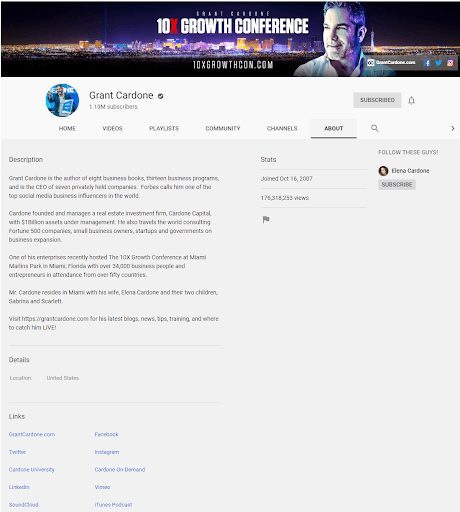
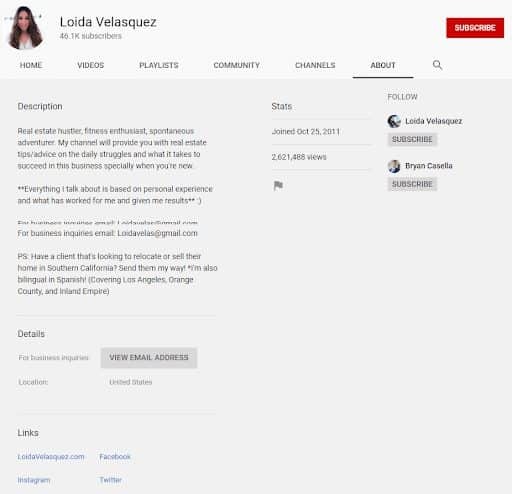
Consistency is the key to establishing an effective real estate YouTube channel. It is essential to share the long-term vision of your company through your channel’s content and engagement efforts. Here’s how to stand out in a crowded marketplace: Invent coined terms and acronyms. Connect old to new, make boring interesting. Create a vlog where you interview like-minded entrepreneurs, and different local business owners, regardless of whether they are working within the real estate industry or not. Spread the word about them, and they’ll reciprocate, in 9 out of 10 cases. #3 - Optimize Your Playlists Creating a playlist will help you organize your content like a pro, and serve as a collection of real estate (and other relevant) videos. What an amazing way to bundle your buyer-oriented and seller-related videos, along with other high-value, significant topics. The playlist will allow users to view a stream of related videos under the same topic, or category. Here’s how real estate moguls, and one of my favorite business minds - Grant Cardone - manages his YouTube playlist:

Bonus Tip - listen to the comments of your viewers, and consider the feedback of your subscribers Reading your audience’s feedback is extraordinarily rewarding. However, this process can become time consuming, especially when your video content starts to take off. You could always get a team member or VA to handle this process later on. This approach gives you the chance to interact with prospects and leads and, more importantly, get their real-time, candid feedback on things such as: what they liked, what they did not like and what they wish to see in the future. You can use this data to further enhance the channel and come up with new topic ideas and video content.
Do You Make These 5 Video Content Optimization Mistakes?
YouTube content optimization comes next. Here’s the first thing to fix. #1 - Create compelling headline titles that drive clicks and are not easy to ignore It is essential to create video titles that include relevant keywords, and can attract users to watch your videos instead of all the other available alternatives. This is the first rule to ranking higher on Google and YouTube for your desired keywords and key topics. The most effective way to create amazing headlines is to use this 3-step combo approach: What comes to mind (based on your experience) What the research tools uncover, and what your target prospects are telling you What your competitors are talking about (identify their best headlines) #2 - Write search-optimized descriptions, detailing each video. Some users even provide a full transcription of their video content, which tend to work wonders for SEO purposes and YouTube rankings. #3 - Use closed captions for the hearing impaired and foreign language speakers

Being sensitive to what your audience needs can go a long way. This includes providing caption text for individuals who cannot hear, or whose main language is not English. Transcripts and Google Translator Toolkit can help in this regard. Making the effort to reach this type of audience could potentially impact you lead generation in a positive way. #4 - Use highly-relevant, custom thumbnails to increase your video CTR

In marketing, you have to adhere to the following principle: promise less, and deliver more. Thumbnails need to be highly relevant to your overall video content or viewers may feel disappointed if your content lacks substance. Sadly, most video creators have learned the science behind creating click-bait thumbnails. Yet, more often than not their content under delivers. #5 - Include relevant call-to-actions and annotations You can easily create call-to-actions (CTAs) using cards in your YouTube videos. You can have up to 5 cards in one video where you can choose whether to add an image, title or call-to-action text, depending on the type of card. In marketing, you have to adhere to the following principle: promise less, and deliver more. Thumbnails need to be highly relevant to your overall video content or viewers may feel disappointed if your content lacks substance. Sadly, most video creators have learned the science behind creating click-bait thumbnails. Yet, more often than not their content under delivers. #5 - Include relevant call-to-actions and annotations You can easily create call-to-actions (CTAs) using cards in your YouTube videos. You can have up to 5 cards in one video where you can choose whether to add an image, title or call-to-action text, depending on the type of card.

Example of a call-to-action popping up in a video of California-based Mainstreet Realtors:
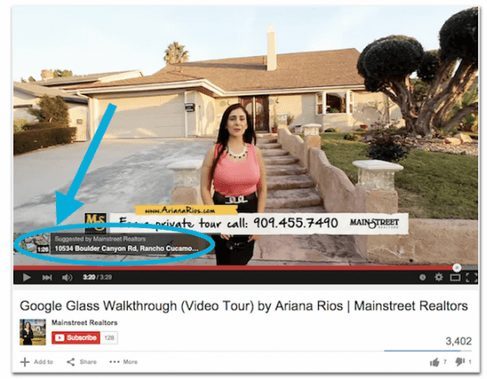
Bonus tip: Geotag your video. Geotagging enables you to associate your video with the GeoCoordinates of your real estate business’ location. This facilitates pick-up of your data by the search engines, therefore, including your page in the results on area searches that are most relevant to your viewers.

Providing your NAP (Name, Address, Phone) on the video will help viewers to connect with you when they reach your video. Video marketing is the exchange of knowledge and experience. Prospects need to feel your energy and understand your insights, things you've developed through practice and time. With the right content marketing plan and the organized approach of your team, you can provide the ideal solution to the biggest real estate challenges and concerns facing your prospects. Because you already know: people buy from other people that they know, like, and trust. That’s the best kept secret in boosting your real estate website traffic and lead numbers, while rendering competitors and their marketing campaigns irrelevant. With the right YouTube strategy, generating leads gets increasingly fascinating and exciting for the real estate industry. Since this channel is growing continuously, it proves to be ideal for ALL real estate companies, regardless of their size, experience or location. You’d be foolish not to leverage this incredible platform to secure your financial stability and grow your business. You should grab this opportunity before the marketplace gets more crowded or YouTube makes it harder for real estate agents and firms to tap into their large traffic polls. Thank you so much for reading The Best Strategy to Increase Traffic and Leads to Your Real Estate Website without Any Referrals, Facebook or Paid Ads. We really appreciate it! If you have any questions about our article, or can suggest any other topics you think we should explore, feel free to let us know. Be sure to sign-up for our newsletter to receive monthly emails on all of the latest trends and happenings in the digital marketing space. You will also receive our FREE E-Book with the Amazing Marketing Tools for Powerful Business Growth. Sign-up below! Also, if you received some value out of this article, please share with your friends or colleagues, or leave a comment/question below. We really appreciate you reading our blog and every share/comment means the world to us and allows us to continue producing valuable tools to help you grow your business! Share this PostAbout the Author

Robb Fahrion Facebook Twitter Google+Robb Fahrion is the Co-Founder and a Partner of Flying V Group. He is passionate about helping businesses grow using the power of the internet. Robb graduated from Chapman University in Orange, CA and currently resides in Costa Mesa, CA. Robb enjoys writing about digital marketing, helping his clients turn their dreams into reality, and is a HUGE Mike Trout fan. The Best Strategy to Increase Traffic and Leads to Your Real Estate Website without Any Referrals, Facebook or Paid AdsNovember 25, 2019What NEVER to Publish on a Real Estate Company Site or BlogNovember 19, 2019Real Estate SEO Tools Exposed: SEMrush vs Ahrefs vs MozPro Review (2019)November 11, 2019
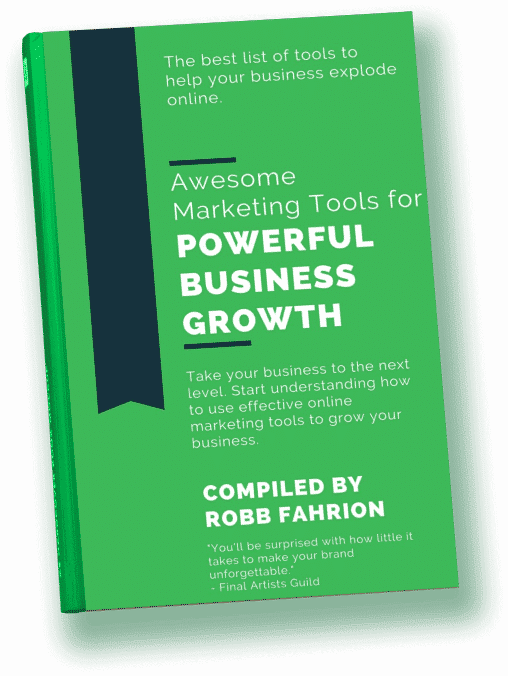
Discover the Best Digital Business Growth Strategies! Join 10,000+ Other Digital Marketers, Consultants, and SEO Experts Now: Notice: JavaScript is required for this content. var formDisplay=1;var nfForms=nfForms||;var form=;form.id='35_1';form.settings={"objectType":"Form Setting","editActive":true,"title":"IN USE - 16 Tools - non-sidebar - copy GLOBAL BLOCK EMAIL GLOBAL","created_at":"2018-10-02 23:58:52","form_title":"Top Ten List Blog - non-sidebar - copy - copy","default_label_pos":"above","show_title":"0","clear_complete":"1","hide_complete":"1","logged_in":"0","wrapper_class":"","element_class":"","add_submit":"0","changeEmailErrorMsg":"Please enter a valid email address!","changeDateErrorMsg":"Please enter a valid date!","confirmFieldErrorMsg":"These fields must match!","fieldNumberNumMinError":"Number Min Error","fieldNumberNumMaxError":"Number Max Error","fieldNumberIncrementBy":"Please increment by ","formErrorsCorrectErrors":"Please correct errors before submitting this form.","validateRequiredField":"This is a required field.","honeypotHoneypotError":"Honeypot Error","fieldsMarkedRequired":"Fields marked with an * are required","currency":"","unique_field_error":"A form with this value has already been submitted.","not_logged_in_msg":"","sub_limit_msg":"The form has reached its submission limit.","calculations":,"formContentData":,"order":0,"type":"part","clean":true,"title":"Part Title","key":"sysrdshp"}],"drawerDisabled":false,"key":"","mp_breadcrumb":1,"mp_progress_bar":1,"mp_display_titles":0,"allow_public_link":0,"embed_form":"","ninjaForms":"Ninja Forms","fieldTextareaRTEInsertLink":"Insert Link","fieldTextareaRTEInsertMedia":"Insert Media","fieldTextareaRTESelectAFile":"Select a file","formHoneypot":"If you are a human seeing this field, please leave it empty.","fileUploadOldCodeFileUploadInProgress":"File Upload in Progress.","fileUploadOldCodeFileUpload":"FILE UPLOAD","currencySymbol":"$","thousands_sep":",","decimal_point":".","siteLocale":"en_US","dateFormat":"m\/d\/Y","startOfWeek":"1","of":"of","previousMonth":"Previous Month","nextMonth":"Next Month","months":,"monthsShort":,"weekdays":,"weekdaysShort":,"weekdaysMin":,"currency_symbol":"","beforeForm":"","beforeFields":"","afterFields":"","afterForm":""};form.fields=,"old_classname":"","wrap_template":"wrap"},{"objectType":"Field","objectDomain":"fields","editActive":false,"order":3,"type":"submit","label":"Sign Up","processing_label":"Processing","container_class":"","element_class":"","key":"sign_up_1556741674462","drawerDisabled":false,"id":"188_1","beforeField":"","afterField":"","value":"","label_pos":"above","parentType":"textbox","element_templates":,"old_classname":"","wrap_template":"wrap-no-label"}];nfForms.push(form); {{{ data.renderProgressBar() }}} {{{ data.renderBreadcrumbs() }}} {{{ data.renderPartTitle() }}} {{{ data.title }}} {{{ data.renderNextPrevious() }}} Read the full article
0 notes
Text
How to Manage Your Entire Marketing Budget [Free Budget Planner Templates]
Let’s say your company decided to invest in a website redesign so you can improve lead generation, and you’re responsible for managing the project. Naturally, one of the first questions you have is, “How much is this website redesign going to cost?” The answer, of course, is “it depends.” Are you simply switching to a new template and adding some new CTAs, or are you migrating your entire website to a new platform? If only there were a way to organize your answers to all of these questions — a place where you could enter in estimated costs for all of your line items, and then compare your projected marketing budget to what you actually end up spending.Good news: Our free marketing budget templates have got you covered. Included in our eight budget templates bundle is a template to manage your website redesign … as well as templates for both Excel and Google Sheets to help you track your content budget, paid advertising budget, event budget, and more. In this blog post, you’ll find the following content (click a link below to jump to that section):
Marketing Budget A marketing budget outlines all the money a business intends to spend on marketing-related projects over the quarter or year. Marketing budgets can include expenses such as paid advertising, sponsored web content, new marketing staff, a registered blog domain, and marketing automation software.
Marketing budgets can be difficult to establish for both small and large businesses. If you’re a small business, you might wonder which marketing expenses you should start with. If you’re a large business, having multiple marketing teams or operations in play can make it harder to ensure everyone across the department gets what they need. So, what should you spend your marketing cash on? First, let’s identify a focal point: According to investment agency, Magna, money spent on digital media will increase by 11.8% in 2019, up from $106.6 million in the U.S. alone in 2018. This includes initiatives that cater to audiences on desktop computers, search engines, video streaming platforms, social media, and mobile devices. Digital media makes up more than half of the country’s total advertising spend. Given the success marketers have seen in it, you might consider spending at least half of your marketing budget on some of the digital channels mentioned above. Marketing Budget Breakdown As you build a marketing budget, here are a few items you’ll want to keep in mind and plan your spending on. Software: When it comes to digital and even print media, you may need software to create your marketing campaigns, or handle your daily processes. Freelancers: If you have a temporary campaign or want to test out a new marketing strategy, you might want to hire a short term freelancer before bringing on a full-timer. New personnel: When you do hire full-time employees, you’ll want to budget costs including their computer, technology, benefits, and onboarding-related needs. Advertising: Budget how much money you’ll spend on paid opportunities such as physical ads, native ads, sponsored content, search engine ads, and social media promotions. Content creation: When you create content such as videos, photos, or even blog posts, you’ll need to put paid time into it. Budget how much money will go into creating this content so you can adjust accordingly based on its return on investment.
How to Create a Marketing Budget Spreadsheet knowledge, alone, won’t help you understand how you’ll spend your marketing money this year. Creating a sound marketing budget starts with knowing what purpose this budget will serve and which marketing teams it will represent. 1. Align your budget with your marketing goals. What you spend and where you spend it will depend on what you’re trying to accomplish. So, when starting to create your marketing budget, make sure you’re only spending money on the things required by your current marketing goals. This can include: Display ads to promote a new product you’re launching this year. Sponsored social media posts to generate followers of your new Facebook page. Paid search engine ads to drive traffic (and purchases) to a specific product page. Contract bloggers to get more organic search traffic to your company’s website. HubSpot’s former Demand Generation Marketer and Trello’s current Growth Marketing Lead, Jessica Webb, says this about how your costs can change when focusing on lead generation vs. lead conversion: “The majority of the money you spend on paid efforts is usually calculated based on volume of clicks or impressions. Because of this, you’ll often want to put more budget toward campaigns with higher-volume offers and audiences.” “For example, a tweet or Facebook ad promoting a lead generation offer that leans more top of the funnel will likely receive more clicks than something that falls more toward the middle or bottom of the funnel,” she explains. Your paid advertising costs will also change depending on how wide of an audience you are attempting to reach. “You can look at Twitter advertising as an example,” Webb explains. “You have to option to target your campaigns based on users’ interests or keywords searched for. Interests are a much broader category, whereas smaller pockets of users are searching for any given keyword, therefore your interests-based audience is going to be much larger and require a larger budget.” To keep better track of your paid advertising efforts, download the Paid Advertising Budget Template (included in the8 Budget Templates to Manage Your Marketing Spend). 2. Beware of hidden costs. One of the great advantages to having and maintaining a budget spreadsheet is that it helps you avoid those end-of-the-quarter or end-of-the-year freak outs when you realize, “Whoa … what did I spend all that money on?” In many cases, unanticipated costs can force marketers to fork over cash that they didn’t plan on spending. Product marketing offers a perfect example. According HubSpot’s VP of Marketing Meghan Keaney Anderson, it’s easy to forget that successfully marketing your products and services requires more than just promotion. “When people allocate budget for product marketing, they tend to think in terms of product launches and promotional activities,” Anderson explains. “That’s certainly an important part of it, but another area of focus to remember is setting aside resources to conduct research and message testing long before the product ever goes to market. Having conversations with customers about the pain points your product will ultimately address is critical to shaping the messaging and having a successful launch.” To better manage your product marketing efforts, download the Product Marketing Budget Template (included in the 8 Budget Templates to Manage Your Marketing Spend). 3. Remember where your priorities lie. Marketing is overflowing with add-ons and extras, upsells, and “premium” versions. One of the best ways to assess what’s nice to have versus what’s absolutely necessary is to (you guessed it) organize all of your expenses. By keeping tabs on where your budget is being allocated, and cross-checking that spending with the results you’re getting, it will be much easier to figure out what should keep getting budget and what should get kicked to the curb.For example, let’s look to the world of public relations. In PR, there are countless tools to which you can allocate budget, which could leave you overspending where it doesn’t matter — and underspending where it does. “Tools abound to help PR practitioners not only create and distribute great content and find and target key stakeholders, but to ultimately measure reach and effectiveness,” says Nathaniel Eberle, HubSpot’s former Director of PR & Brand and LogMeIn’s current Director of Global Brand Management. “The key is making sure you’re laser-focused on who you’re setting out to reach and influence, then ensuring that your budget supports how they’ll most likely want to receive (and share) your key messages. “As the media and digital landscape evolves at breakneck speed, continually reassessing the tools, services, and programs you’re employing is a great way to determine real-time ROI of your overall spend. Today’s measurement tool may be worthless to you tomorrow.” To get better at prioritizing your PR line items, download the PR Budget Template (included in the 8 Budget Templates to Manage Your Marketing Spend). 4. It’s not all about the Benjamins. When you open up these budget templates and check out all the various expenses detailed in them, don’t fret if you can’t tick every box. I’m not advocating for an “always spend more” approach to marketing. I’m advocating for an “always spend smart” approach. The expenses listed out aren’t mandatory — they’re just meant to guide your thinking and to help ensure that you haven’t overlooked any hidden costs. 5. Prepare to measure ROI. When you put a certain amount of money into a certain area, you’ll want to determine if your budgeting helped you or hurt you as you plan out future budgets. The best way to do this is by measuring ROI — or return on investment. If you’re the money you spend on one item results in your company making more in return, you may want to increase budget in the next year. If your money went nowhere, you should examine your budget. With that in mind, here’s the full list of budget templates included in the bundle.
8 Marketing Budget Templates You Need to Manage Your Marketing Spend With the 8 Free Budget Planner Templates to Manage Your Marketing Spend, you’ll be able to manage all of the moving pieces of your budget at a monthly and quarterly level. Use the Excel version of the templates to keep all of your budgets in one place. When you download the zip file, you’ll find a separate file for each marketing team, as well as a Master Budget Template to maintain a high-level view of your overall expenses. Interested in sharing your marketing budget across a larger team? Try the Google Sheets version of the same eight templates to share access with other Gmail users. For the Google Sheets templates, each team budget is found in a separate tab of the same Google Sheet. No matter which version you choose, each budget is optimized with the same line items, tips, and graphs. Read on to learn how to use each budget template. 1. Master Marketing Budget Template Download the Master Marketing Budget Template here. While it’s helpful to have individual budget templates for specific marketing departments and activities, it’s also nice to be able to take a step back and see the bigger picture. The Master Marketing Budget Template lets you do just that: It’s the place where you can collect the totals from the other seven templates in the bundle and see all of your expenses in one place.
2. Product Marketing Budget Template Download the Product Marketing Budget Template here. This template will guide you step-by-step through the process of budgeting for a product launch. From determining product/market fit, to running user testing sessions, to promoting your finished product, our Product Marketing Budget Template will help ensure you don’t overlook any important expenses.
3. Content Budget Template Download the Content Budget Template here. The budget required for creating and promoting content can vary greatly from organization to organization. For example, while some organizations keep most of their content operations in-house, others rely more heavily on freelancers and contractors. And while some use many different software products, publishing tools, and services, others take a much simpler approach. Our Content Budget Template is designed to cover as many content-related bases as possible. So, if you see any expenses listed that don’t apply to your organization, go ahead and delete them. (That’s the beauty of Excel spreadsheets: You can customize them to your specific needs.)
4. Paid Advertising Budget Template Download the Paid Advertising Budget Template here. Paid advertising: Does it really qualify as an inbound marketing tactic/channel? That is a loaded question, my friends, and one that I don’t have room to answer in-depth in this post. What I can tell you for sure is that you can do paid advertising in an “inboundy” way — i.e. by targeting specific buyer personas and using paid advertising as a supplement to your organic efforts to help drive awareness and conversion opportunities. Measuring the effectiveness of your paid advertising campaigns is also paramount to doing things the inbound way. Using our Paid Advertising Budget Template, you can keep tabs on your monthly (and quarterly) ad spending, and then cross-reference the amounts with your lead-generation metrics to determine your cost-per-lead.
5. Public Relations Budget Template Download the Public Relations Budget Template here. Public relations expenses amount to more than just paying for press releases. From reputation monitoring software, to traveling (e.g., to events and tradeshows), to applying for awards, there are many PR costs that can be all too easy to overlook. To ensure you’re accounting for all of your organization’s PR-related expenses, check out our Public Relations Budget Template.
6. Branding & Creative Budget Template Download the Creative Budget Template here. In order to produce high-quality, innovative graphics, videos, and other content, the branding and creative teams of today need more than just Photoshop … a lot more. One of the largest — and often most overlooked — expenses is storage. If your organization is producing a lot of video, storage is especially important. Because as it turns out, when budgeting for video storage, you shouldn’t be thinking on a megabyte (MB) or even a gigabyte (GB) scale, but on a terabyte (TB) scale. FYI: 1 terabyte = 1 trillion bytes. You can keep track of all your storage costs (and other branding and creative costs) using our free template.
7. Website Redesign Budget Template Download the Website Redesign Budget Template here. Budgeting for a website redesign can be seriously tricky. With so many moving pieces to consider, there is a lot of room for underestimating or miscalculating costs. We created our Website Redesign Budget Template so you can keep all of your redesign-related expenses in one convenient location. Unsure if your current website is right for a redesign? Check out this HubSpot research report: Does Your Website Make the Grade? Chances Are, It’s Barely Passing.
8. Event Budget Template Download the Event Budget Template here. When planning an event, the associated costs can seem obvious at first. There’s the venue to consider, of course. And the P.A. system and microphones. And then the costs associated with booking and bringing in presenters/performers. That’s pretty much it, right? Wrong. For example, does the venue come with tables/chairs, or will you have to rent those separately? Do you want your attendees to wear name tags, and if so, will you be printing out the name tags ahead of time or will attendees be writing their own names on blank tags? If the latter, have you factored in the pens or markers you’ll need to accommodate that? As you can see, planning for an event can lead you down many rabbit holes. Use our Event Budget Template to stay organized.
Sample Marketing Budget With your chosen template downloaded, it’s time to consider which digital channels to allot a budget for. Hint: There’s no right answer — it’ll depend the market research you do to figure out where your specific audience spends most of its time. If you find your buyer prefers learning and consuming content in the form of video, for example, you might invest more of your money in YouTube advertising. Alright, enough explanation. Here’s a small, sample budget for a quarter’s worth of expenses by a hypothetical company that has decided to invest heavily in video marketing. This template was created using the Master Budget Template, the first template listed in the section above.
Based on the figures above, video advertising’s total expenses for the quarter exceeded budget by $20, while full-time recruitment’s total expenses exceeded budget by $2,400. This means the company is trending over budget for the first three months of the year. Why might this happen? Perhaps a pay-per-click (PPC) campaign on YouTube received more clicks by viewers than expected, and a sharp video-savvy job candidate negotiated a higher salary. Based on the difference between this company’s planned spend and actual spend, their budget template produced the following graph: Go now, and plan wisely — your marketing staff is counting on you. Editor’s Note: This blog post was originally published in December 2015, but was updated in January 2019 for comprehensiveness.
Source link
source https://www.kadobeclothing.store/how-to-manage-your-entire-marketing-budget-free-budget-planner-templates/
0 notes